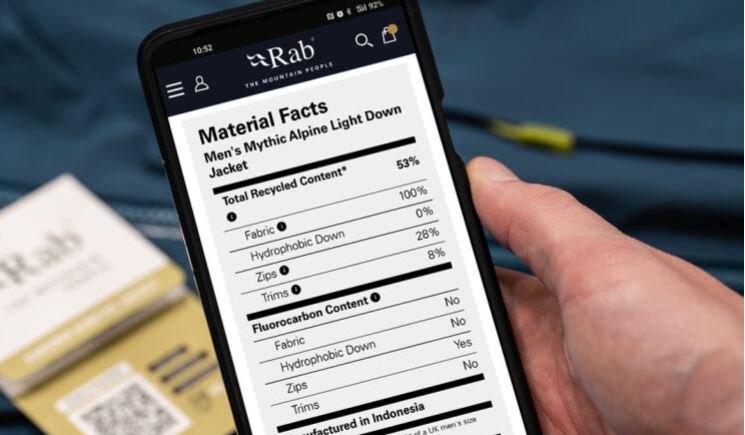Our Commitment to Phase-Out PFAS
Per- and polyfluoroalkyl substances (PFAS) are a category of synthetic chemical that are used to make products waterproof. In the quest to make outdoor gear that can withstand the toughest adventures in the harshest environments, the outdoor industry has relied on these harmful solutions for far too long. Here we take a deep dive into PFAS use and look to the future of waterproof outdoor gear.
The terms Fluorocarbons, PFCs, PFAS and C-numbers have gradually gained more traction over the years as consumers become more environmentally conscious of their purchases. They've been knowingly used in outdoor clothing for the last century, but their use has a significant environmental impact.
What are they?
When they were first developed, PFAS were a seemingly innocent and miraculous invention, shedding liquid, dirt and oil from manufactured products with ease. At the time it was thought that these chemicals were also the only way to allow maximum breathability for membranes used in waterproof gear. In turn making them incredibly durable, comfortable, and longer-lasting. This durability also means that they are commonly used in household items such as cookware, carpets, toiletries- even takeaway boxes.
The characteristics of PFAS means they're the perfect addition to outdoor products, adding PFAS to a fabric means water beads on its surface and rolls off, rather than being absorbed. Forming a basis for membranes and weather-proof treatments such as durable water repellent (DWR) coatings in outdoor clothing, shoes, tents and backpacks as well as a multitude of other consumer products.
But, the 'long-lasting' quality offers a longer lifetime guarantee than initially bargained for. PFAS do not occur in the natural environment and can't be degraded promptly by water, light or bacteria. Often referred to as 'Forever Chemicals', these synthetics can take as long as 1,000 years to degrade.
Where are they?
There’s increasing research that demonstrates PFAS can leach from materials and gradually find their way into the water system. Although these substances do not occur naturally in nature, they can now be detected everywhere on earth. The compounds themselves have been associated with health problems in both wildlife and people, and they have been highlighted to be persistent, bio-accumulative and toxic. The impact of outdoor clothing as a route of exposure has been explored but is still not wholly understood.
Outdoor clothing isn’t the only source of exposure. PFAS are used widely in firefighting foams, non-stick metal coatings, paper food packaging, creams and cosmetics, textiles for furniture, paints, chrome plating, pesticides, and pharmaceuticals, but as an outdoor industry, we recognise we must take responsibility to initiate change. Even more so because our people see the effects on the natural world first-hand and want to do what we can to protect it.
Our Progress
Our DNA has always been to develop technical, high-performing durable products that are fit for purpose. For over 40 years, we’ve been keeping people warm and dry so they can safely spend more time in the outdoors.
As part of our commitment to reduce our environmental impact, we set ourselves targets to find alternative solutions that provide an equal amount of protection; without compromising technical performance.
These targets were set at a time when a clear path for achieving them was still unclear, our success has always been dependent on our ingredient partners sharing similar goals and taking actions that influence our products.
It’s harder than we thought, but we’re getting there.
We’ve eliminated the most harmful longer-chain PFAS chemicals (C8) and looked for other ways of maintaining water repellency, breathability, and durability from smaller-chain PFAS (C6) that are less harmful to the environment.
The remaining styles are those that demand the highest standards in performance and durability, and where alternative options evaluated have yet to meet the performance criteria.
Our journey to phase out PFAS from all our products has been an ambitious one. We missed our AW24 target, but we’re still working with our ingredients partners to eliminate all intentional use of PFAS from our ranges by AW25. Not just from fabrics, but zips and trims too.
Material Facts
We believe that marketing a product as ‘PFAS-Free’ should apply to the full product, not just its DWR.
Our Material Facts tables launched last year which transparently indicate where PFAS are still in use in our products.
Consumers can search by component where PFAS are present, either in the fabric, down, zips or trims, so that they can make a more informed decision around their purchasing choices.
Product Care
We want to make sure that the garments we create have as low impact on our planet as possible. Ensuring our products stay useful and effectively caring for clothing is essential to make sure we aren’t making more of an impact than we need to.
To ensure optimal performance, we encourage our consumers to regularly maintain, wash, and re-proof their waterproof products, particularly as these are updated to PFAS-free DWR alternatives. As we move to newer less harmful alternatives, the way that we care for these garments is changing.
Garments with a PFAS-free DWR coating may appear to ‘wet out’ quicker and not always demonstrate the iconic ‘beading’ that we have come to expect. Over time the DWR coating may deteriorate, causing the garment to soak up moisture, affecting its weight and breathability. Sweat, dirt, and residue from cosmetics and lotions can also become impregnated into the fabric.
Expectations will need to shift as more care is required to maintain water repellency and breathability:
Washing waterproof garments is key to performance and longevity. Wash more frequently (every 1-3 months), use a cleaner that is designed for waterproof shells, and avoid fabric softeners, which coat the fabric and make it less water-repellent.
Tumble dry (or iron under a cloth) to finish, as heat is an essential part of reactivating the water-repellent properties.
If a garment starts to soak up moisture ‘wetting out’, it’s time for re-proofing. Incorporate a PFAS-free re-proofing solution when performing the above steps.
Suitable product care can be performed at home, but the Rab Service Centre also provides professional wash and reproofing services.
Find out more
You can find out more about our journey to phase out PFAS in our annual Sustainability Report.
Search for Rab’s PFAS-Free Products here.




